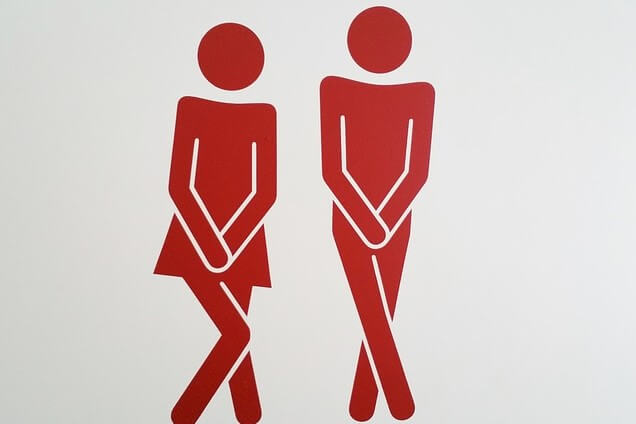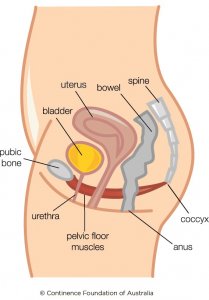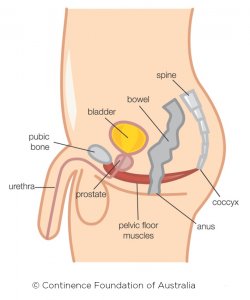It is common, but it is not normal – and there are things you can do to help. There is good evidence that if you strengthen your pelvic floor muscles, you can reduce or even cure urinary leakage problems.
Types of urinary incontinence
Stress incontinence – This occurs when a physical movement or activity (eg cough, sneeze, run) puts pressure (stress) on the bladder.
Urge incontinence – This is a sudden, strong urge to go to the toilet, accompanied by leakage, even when your bladder isn’t very full.
Pelvic floor muscles
These are a group of muscles that form a sling under your pelvis – reaching from the pubic bone at the front to the tail bone at the back.
Female pelvic floor Male pelvic floor
(Reproduced with permission from Continence Foundation of Australia)
The pelvic floor muscles help with:
- Bladder and bowel control
- Emptying of the bladder and bowel
- Keeping pelvic organs in the right place
- Sexual function
How do you do pelvic floor muscle exercises?
- Sit up straight, relax your tummy and inner thighs
- Squeeze and lift as though you are trying to hold back urine, or stop passing wind
- There should be a gentle pulling in of the lower tummy, but not breath holding, tilting of the pelvis or buttock squeezing
- Start with a 2-3 second hold, and gradually build up to 10 seconds as you get stronger. If your muscles are weak, you won’t be able to hold for long to begin with.
- Allow a 10 second rest between each muscle contraction to avoid muscle fatigue
- Gradually build up to 10 repetitions, of 10 second holds, with a 10 second rest between. Aim to do your exercises three times a day.
How do you know if you’re doing them correctly?
If you can slow down or stop your flow of urine half way through emptying your bladder, then you are using the correct muscles. (Do NOT do this as a way of exercising your muscles, it is just a TEST).
If you’re unsure, book with a qualified pelvic health physiotherapist for help.
Longterm care of the pelvic floor
If your pelvic floor muscles are weak, it may take 3-4 months to build up strength. Once you have good strength, aim for one good set each day for maintenance.
Risk factors for incontinence:
- Constipation and straining
- Ageing
- Obesity
- High impact sports, inappropriate exercise
- Persistent coughing, sneezing
- Smoking and caffeine consumption (may increase urge incontinence)
- Lack of general fitness
AND
- for men – prostate surgery
- for women – pregnancy, childbirth, menopause and hormone changes
What can you do to help?
- Pelvic floor muscle training
- Maintain a healthy weight
- Limit bladder irritants (caffeine, alcohol)
- Seek help to quit smoking
- Ensure adequate fluid and fibre intake, and seek help for constipation
- Pelvic floor safe general exercise (see www.pelvicfloorfirst.org.au)
If you have a problem with urinary leakage – you are not alone. You can get help. Don’t suffer in silence.



